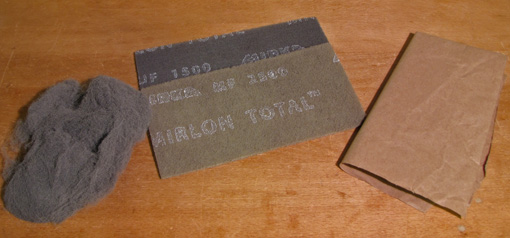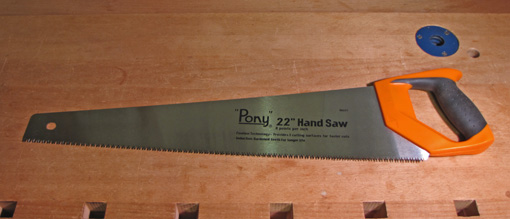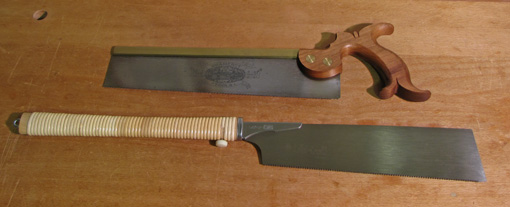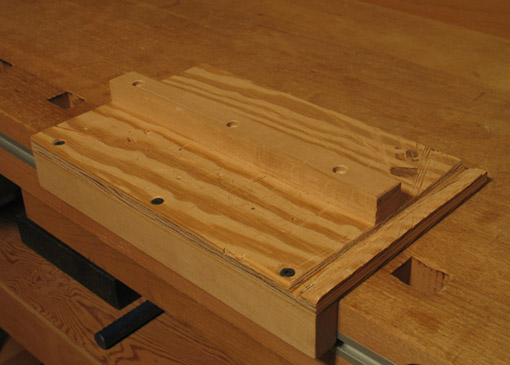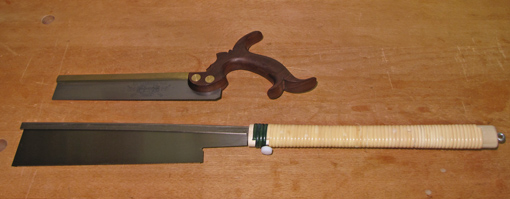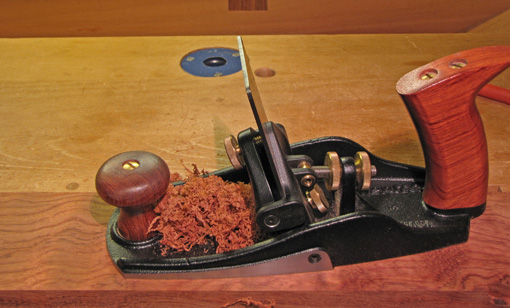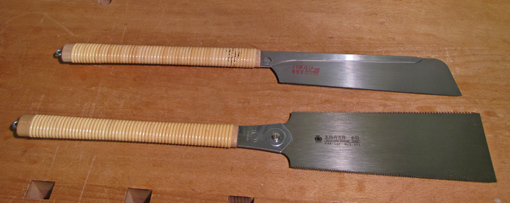
I cut tenons with a Japanese ryoba saw, the larger of the two saws pictured above. The reasons are simple: I get excellent results and have been using ryobas for more than 25 years.
I have tried several excellent Western tenon saws from top makers and I must admit that I have not found the comfortable accuracy and reliably clean cut surfaces that I get from the ryoba. I concede this probably is a matter of habit and I would eventually become as comfortable with the right Western tenon saw as I am with my ryoba. So, rather than saying one type of saw is better than the other, I am sharing my preferences, and the reasons for them, in the hope that this may help other woodworkers find what works for them.
My saw is a Gyokucho model #611, 240 mm (9 ½”), available from Japan Woodworker, item # 19.611.0, $38. Replacement blades are $24.50. This saw has a 0.018″ saw plate, rip teeth that grade from 10 tpi at the handle end to 7 tpi at the far end, and 20 tpi crosscut teeth, both set 0.005″ each side.
I start cutting a tenon using the crosscut teeth to split the layout lines at the corners, establishing shallow kerfs. Switching to the rip teeth, I connect those starter kerfs across the end of the tenon. Once the rip teeth are buried, I cut on a diagonal on the layout line down the length of the tenon on one side, then the other. Finally, I saw away the remaining triangle of wood at the base of the tenon.
The backless ryoba, with a generous width of almost 4″ at its far end, gives excellent sight lines. The sawing is done with a surprisingly light touch since the progressively coarser rip teeth provide plenty of aggressiveness on their own. This allows me to watch the layout line when sawing diagonally down one side of the tenon while feeling the saw riding in the kerf that was established at the top of the tenon. The key point is that I don’t want to fight the kerf that was already established. The lightness of the ryoba and, paradoxically, its flexibility and aggressive teeth, convey excellent sensitivity to do this. (The eyes cannot precisely sight two separate lines at the very same moment.)
The low cost and replaceable blades belie the excellent performance of this saw. I suppose a handmade ryoba costing a few hundred dollars (that I would not have the skill to sharpen on my own) would be subtly better but I don’t feel compelled to go there, at least now. The quality control and value in Japanese machine-made saws such as the Gyokucho and Z brands are amazing.
The ryoba also does general small to medium scale ripping and crosscutting, such as cutting a haunch in a tenon. In my opinion, Japanese backsaws are the wrong tool for cutting furniture size tenon cheeks. However, a tiny tenon, such as in a small drawer handle, can be cut with a Japanese or Western dovetail backsaw. For very large tenons in low to medium density woods, a large Japanese single-edge (kataba) ripsaw is a good option. I will discuss such a saw later in this series.
The other saw in the picture is a crosscut dozuki saw which I like for cutting the tenon shoulders. It is a Z brand saw, 240 mm (9 ½”), 25 tpi, 0.012″ saw plate, 0.016″ kerf, available from Rockler, item #65607, for $44.99, replacement blades $27.49. (Why do they insist on calling it a “dovetail saw?” It is not.) It is thin, straight, and sharp enough to settle against a knifed and deepened shoulder line. A Western “carcase saw,” discussed in the next post, is another good option for this task.
Next: small to medium crosscut work and the carcase saw
